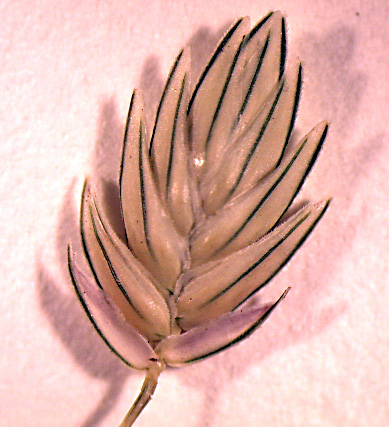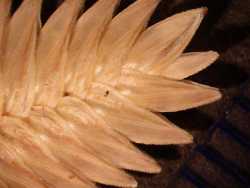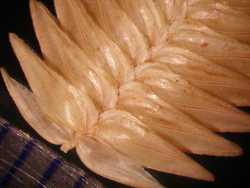|
|
|
|
Family: Poaceae
Wilman lovegrass
|
Plants perennial; cespitose, with innovations, without glands. Culms 45-95 cm, erect, glabrous. Sheaths hairy at the apices and on the margins, hairs to 6 mm; ligules 0.5-1.2 mm; blades 7-30 cm long, 2.5-7 mm wide, flat to loosely involute, glabrous abaxially, scabrous adaxially, margins sharply scabrous. Panicles 10-30 cm long, 1-6 cm wide, oblong, condensed, interrupted below; primary branches 1-11 cm, appressed or diverging to 40° from the rachises, naked basally; pulvini glabrous; pedicels 0.5-25 mm, with a narrow band or abscission line below the apices. Spikelets 5.5-16 mm long, 2.7-9 mm wide, ovate, flattened, greenish to stramineous, sometimes with a reddish-purple tinge, with 4-22 florets; disarticulation below the glumes, spikelets falling intact. Glumes equal, 3-4.5 mm, ovate, chartaceous; lemmas 3-5 mm, broadly lanceolate, chartaceous to leathery, lateral veins green, apices acute; paleas 3-5 mm, chartaceous to hyaline, keels broadly winged below, forming a wing or tooth on each side that often projects beyond the lemma bases, apices acuminate; anthers 3, 1.4-2.8 mm, golden-yellow. Caryopses 1-2 mm, ellipsoid, adaxial surfaces flattened, reddish-brown. 2n = 40. Eragrostis superba is native to Africa, where it is grown for hay, being fairly palatable and drought resistant. It is also used for erosion control and revegetation. In the Flora region, it grows on rocky slopes, in sandy flats, and along roadsides, at 480-1650 m, often with Acacia, Prosopsis, Fouquieria splendens, Juniperus, and Quercus. The English name is an appropriate description of the leaf blades. FNA 2003 Common Name: Wilman lovegrass Duration: Perennial Nativity: Non-Native Lifeform: Graminoid General: Cespitose perennial, without glands; culms 45-95 cm, erect, glabrous. Vegetative: Sheaths hairy at the apices and on the margins, hairs to 6 mm; ligules 0.5-1.2 mm; blades 7-30 cm long, 2.5-7 mm wide, flat to loosely involute, glabrous abaxially, scabrous adaxially, margins sharply scabrous. Inflorescence: Panicles 10-30 cm long, 1-6 cm wide, oblong, condensed, interrupted below; primary branches 1-11 cm, appressed or diverging to 40- ; pulvini glabrous; pedicels 0.5-25 mm; spikelets 5.5-16 mm long, 2.7-9 mm wide, ovate, flattened, greenish to stramineous, sometimes with a reddish-purple tinge, with 4-22 florets; disarticulation below the glumes, spikelets falling intact; glumes equal, 3-4.5 mm, ovate, chartaceous; lemmas 3-5 mm, broadly lanceolate, chartaceous to leathery, lateral veins green, apices acute; paleas 3-5 mm, chartaceous to hyaline, keels broadly winged below, forming a wing or tooth on each side that often projects beyond the lemma bases, apices acuminate; caryopses 1-2 mm, ellipsoid, adaxial surfaces flattened. Ecology: Rocky slopes, sandy flats, and along roadsides, 1574 - 5413 ft (480-1650 m). Distribution: Native to Africa; n Amer in CA, s AZ, s NM, s and c TX; south through MEX and s Amer. Notes: Easy to recognize by a combination of large, flattened, ovate (egg-shaped) spikelets (see pics and measurements above) with many florets, opposite one another at broad angles from the rachises and lower nodes which sprout into offsets or new shoots. Ethnobotany: unknown Etymology: Eragrostis is from Greek eros, love and agrostis, grass, while superba is from the latin superbus, -very fine, grand, proud-. Synonyms: None Editor: FSCoburn |




